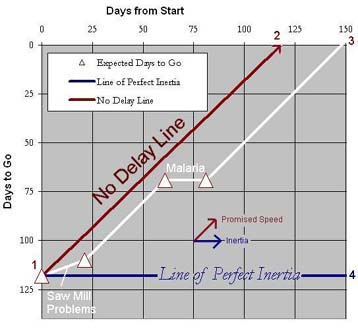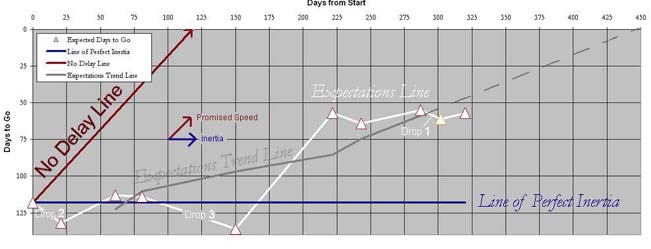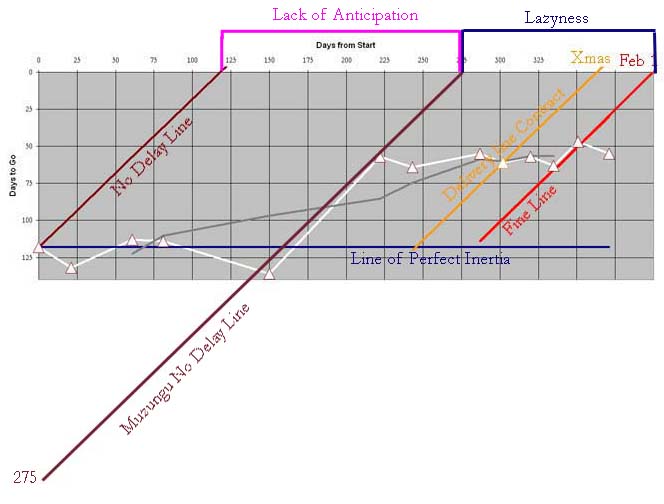
| Greetings Home |
| The Other Introduction To East Africa Home |
| African Economics Home |
Created 05-11-17
Last edited 19-02-09
Perfect Inertia
Towards A General Model Of African Business Planning
You may profit by first reading the general page on African time.
The basic principle of African business is the principle of perfect inertia.
Consider the graph below:

Graph: No Delay Line (brown), a 20% delay line (white with triangles),
and
the Line Of Perfect Inertia (blue, horizontal). (Open
in separate window)
In the example of my dhow (pages marked "![]() "
in Personal Vicissitudes) I was told at the start, day zero, it would be ready
in four months. I was led to consider myself in point 1, some 120 days to
go. Assuming no delay, some 120 days later I would be in point 2: Zero days to
go, that is, delivery. The brown No Delay Line is exactly 45o angle.
By way of illustration and exercise, I add an imaginary case in which saw mill problems force my
yard boss, after 20 days to adjust the expectations: the delay is estimated at
10 days. At days 63 he gets a bad malaria putting work to a halt for 20
days. We end at the top of the graph, that is zero days to go, that is delivery
at day 150 instead of 120, a delay of 30 days or 25% .
"
in Personal Vicissitudes) I was told at the start, day zero, it would be ready
in four months. I was led to consider myself in point 1, some 120 days to
go. Assuming no delay, some 120 days later I would be in point 2: Zero days to
go, that is, delivery. The brown No Delay Line is exactly 45o angle.
By way of illustration and exercise, I add an imaginary case in which saw mill problems force my
yard boss, after 20 days to adjust the expectations: the delay is estimated at
10 days. At days 63 he gets a bad malaria putting work to a halt for 20
days. We end at the top of the graph, that is zero days to go, that is delivery
at day 150 instead of 120, a delay of 30 days or 25% .
Now there is another line in the graph. It is
the blue Line Of Perfect Inertia. It represents how the thing evolves
when nobody does anything. It seems totally irrelevant, but it is the most important reference in the
model of delay we are dealing with: The African Model. A real African
delay illustration (my dhow) is represented below:

As you see, it is the No Delay Line that is totally irrelevant. Most readers will be astonished by seeing the Expected Days To Go (white) immediately jumping below Perfect Inertia (blue). How is this possible? The answer is this: 1. You do absolutely nothing (very important!), 2. You form some disturbing thoughts about necessary actions to complete the work that you previously did not think of - OR you thought of but thought wise not to tell your client. Any period of prolonged inertia results from a balance between some things done and adding some unexpected new items on the to-do list, unexpected only to the customer OR even to the contractor.
The "OR"
The thing is that the white line represents expectations communicated by the yard boss to the client. Perfect Inertia is modeling the subtle African business interplay between believe and make believe. The "OR"'s need explanation and thorough understanding:. African language is persuasive and power regulating. It is wrong to interpret a statement like
It is not far.
as a statement of fact. A person giving such an answer says so because he does not want to be the messenger of bad news, and wishes to give you the courage (power) to continue your journey. You might very well end in a swamp at midnight. The same holds for
It is still very far.
This could for instance be followed by "Why don't you stay for the night in my hotel". It is meant to persuade you to give up reaching your destination now. The next day you might discover your destination was only four minutes down the road.
This is a complicated issue indeed. It concerns culture differences in ideas of what a language is, and what you do with it. Details language.
Expectation Drops Considered More Closely
In the graph, you see the expectations drop four times. Such things happen in some typical cases:
Drop type 1 (see graph above): the contractor sees his promises in a written contract containing sanctions for cases in which deadlines are not met, and he is asked to sign, a western trick. The typical African business man is not deeply impressed: moderate instantaneous drop.
Drop type 2: the contractor has pushed his expectations up in order to get a money advance from the customer, however the advance has just been received (sharp instantaneous drop)
Drop type 3: the client has been absent for a while and returns to the work (moderate drop or horizontal movement, but over a longer period, hence usually more harmful than the other two cases. At drop 3 in the graph above I was abroad and left business for a few months to representatives).
The theory of Perfect Inertia is intimately connected with the African views on
language
and time, which radically differ from the western ones (details:
language
and time, ).
Another Example : Pramukshwami Delivers Paint

Summary: 7 days after my order we were back on the line of perfect
inertia. From day 12 to day 23 we were again inert, parallel to the line of
Perfect Inertia at 4 days above that line.
At delivery on day 24 we have a
delay ratio of roughly 5. Remarkably similar to the dhow case, which had a
process expected to range over 4 months. Delivery takes 5 times longer than the client
initially is made to believe. I can add the case of Jeremia supplying a table,
chairs cabinet and shelves with again a delay ratio of roughly in the order of
5.
To my surprise Pramukshwami, an Indian paint shop keeper, is not below the
native Tanzanian delay ratio. Of course one may stubbornly believe he just had the
bad luck to perform far below his average this time.
Moving parallel inertia usually is a combination of doing some work and, while doing that work discovering unexpected necessary jobs of roughly equal duration. A significant part on inertia is hence due to ignorance of the the full weight of remaining jobs. In the case of my dhow, my estimation is like this:

While the African in his ignorance expects to finish the job in roughly 125 days, a muzungu would anticipate almost all jobs to be done and more or less correctly expect 275 days. If you work properly, that is. If my rough estimate is right, 150 days of the delay in the building of my dhow is to be attributed to lack of anticipation and the remaining 125 to lazyness (and corruption).
Perfect Inertia in the Dhow Building Logbook:
Occurrence 1, Down Inertia
Occurrence 2, Doldrums
Occurrence 3, Nataka Pesa (introducing the expectations trend line)
Occurrence 4, Grand Finale
Occurrence 5, The Mother Of Doldrums
Occurrence 6, Wrong Screws, No Wood
Occurrence 7, Curtain for Daniel
Occurence 8: Final graph